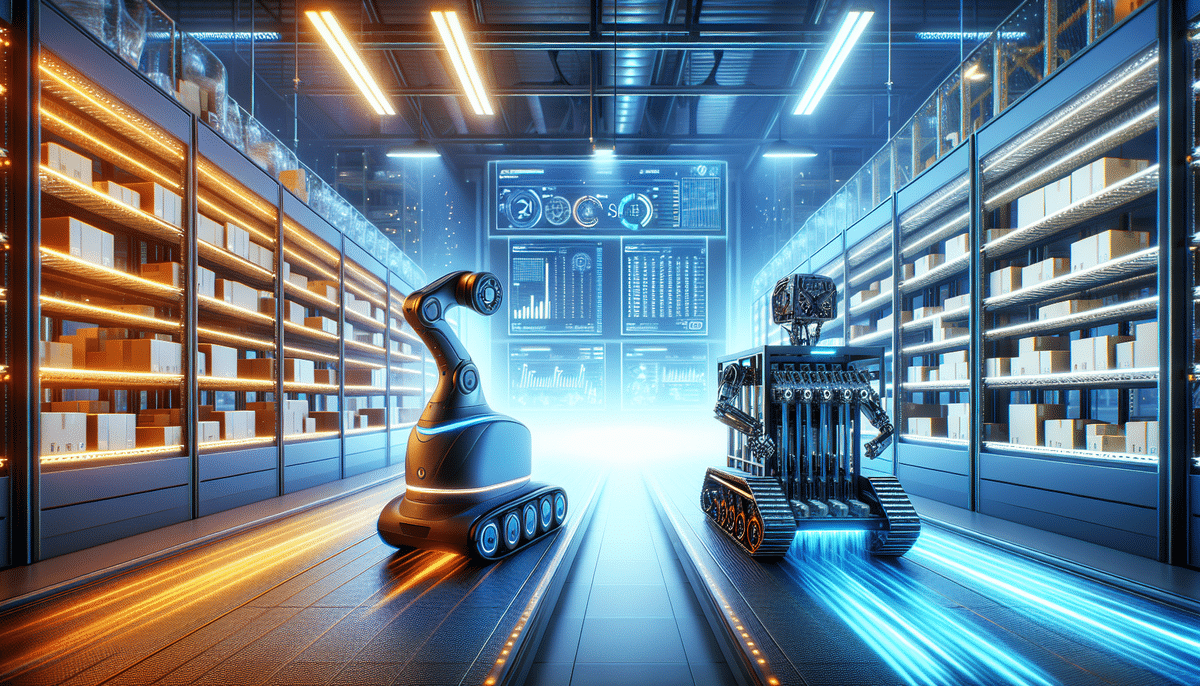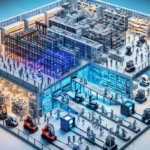Fetch Robotics vs GreyOrange: Comprehensive SEO Comparison
Introduction
In the competitive landscape of robotic solutions for logistics and warehousing, Fetch Robotics and GreyOrange emerge as leading innovators. Both companies offer state-of-the-art technologies tailored to address modern supply chain challenges, enhancing efficiency, productivity, and safety. This analysis provides an in-depth comparison of their offerings, technologies, performance metrics, and more to help businesses determine which provider best aligns with their operational needs.
Company Profiles
Fetch Robotics
Fetch Robotics specializes in autonomous mobile robots (AMRs) designed for material handling and inventory management. Founded in 2014 by Melonee Wise and Steve Hogan, the company is headquartered in San Jose, California. To date, Fetch Robotics has secured over $94 million in funding, demonstrating strong investor confidence in its innovative automation solutions.
The company's flagship products include the Fetch Mobile Manipulator and the Freight Mobile Robot. The Fetch Mobile Manipulator is engineered for versatility, capable of tasks ranging from material transport to precise item placement on shelves. The Freight Mobile Robot focuses on autonomous material transport within industrial environments.
Fetch Robotics' software platform, FetchCore, facilitates fleet management and operational monitoring, providing real-time data and analytics to optimize performance. Recognized as a Cool Vendor in IoT Analytics by Gartner in 2018, Fetch Robotics has established strategic partnerships with industry leaders like SAP and Ricoh to integrate their robotics solutions across various sectors.
GreyOrange
GreyOrange was founded in 2011 by Samay Kohli and Akash Gupta and is based in Singapore, with additional offices in India, Japan, Germany, and the United States. The company has raised over $170 million in funding, underscoring its significant impact on the logistics automation landscape.
GreyOrange's product lineup includes the Butler and Sorter systems, as well as the Ranger AMR. The Butler system automates inventory storage and retrieval using AI and machine learning, significantly reducing the time and effort required for inventory management. The Sorter system automates parcel sorting and routing, capable of handling up to 18,000 items per hour, making it ideal for high-volume logistics centers.
The Ranger AMR is designed for autonomous navigation within warehouses, performing tasks such as inventory management, order picking, and material handling with precision and efficiency. GreyOrange has forged partnerships with major logistics players like DHL and Walmart, enhancing its global footprint and validating the effectiveness of its automation solutions.
Technological Comparison
Advanced Sensor Integration
Both Fetch Robotics and GreyOrange leverage cutting-edge sensor technologies to power their robotic solutions. Fetch Robotics employs a combination of sensors, cameras, and sophisticated algorithms to enable their robots to navigate complex environments and interact safely with objects and human workers.
GreyOrange utilizes a similar array of sensors, including laser scanners and 3D cameras, to create detailed maps of their operational environments. Their systems are enhanced with machine learning algorithms that optimize movement patterns and operational efficiency.
Key Technological Differences
- Collaboration vs. Efficiency: Fetch Robotics focuses on collaborative operations, ensuring robots can work alongside humans without interference. GreyOrange emphasizes high-speed, high-volume operations, optimizing for maximum throughput in large-scale environments.
- Algorithmic Optimization: While both companies use machine learning, GreyOrange's algorithms are geared towards optimizing entire workflows, whereas Fetch Robotics concentrates on real-time collision avoidance and adaptive task execution.
Feature Comparison
Fetch Robotics Features
- Versatile Manipulation Capabilities: The Fetch Mobile Manipulator boasts a 7-axis robotic arm, a 2D LiDAR scanner, and a 3D depth-sensing camera, enabling it to handle payloads up to 20 kg and achieve speeds of 1.8 meters per second.
- Real-Time Fleet Management: FetchCore allows for seamless monitoring and management of robotic fleets, providing actionable insights through real-time data analytics.
- Seamless Human-Robot Collaboration: Designed to work alongside human workers, enhancing productivity and workplace safety.
GreyOrange Features
- High Sorting Throughput: The Sorter system can manage up to 18,000 items per hour, making it a powerhouse for high-volume logistics operations.
- Modular System Designs: GreyOrange systems are designed for easy configuration and scalability to meet varying operational demands.
- Integrated Machine Learning: Enhances workflow optimization and operational efficiency across diverse environments.
Performance Metrics
Fetch Robotics Performance
Fetch Robotics' solutions have demonstrated significant performance improvements, boosting productivity by 30-50% and reducing labor costs by up to 70%. These metrics make Fetch Robotics an attractive option for businesses looking to enhance efficiency without extensive operational overhauls.
GreyOrange Performance
GreyOrange's systems have achieved impressive performance metrics, with customers reporting up to a 90% reduction in operational incidents and a 40% increase in overall efficiency, particularly in high-demand environments. Their end-to-end solutions encompass not just hardware but also sophisticated software and analytics tools to fine-tune performance metrics.
Pros and Cons
Fetch Robotics
- Pros: High flexibility and versatility, user-friendly interfaces, easy customization, cost-effective for smaller businesses, and collaborative operation with human workers.
- Cons: May require more frequent adaptation in highly dynamic, fast-paced environments compared to specialized systems.
GreyOrange
- Pros: Exceptional speed and accuracy, high scalability, robust performance in high-volume settings, and comprehensive end-to-end automation solutions.
- Cons: Higher initial investment costs and a steeper learning curve, potentially necessitating additional training for workforce integration.
Use Cases
Fetch Robotics Use Cases
- Distribution centers and warehouses requiring flexible, mobile automation.
- Manufacturing facilities needing adaptable material handling solutions.
- Healthcare and retail industries that require frequent inventory checks and updates.
Fetch Robotics' robots excel in environments where tasks vary and adaptability is paramount. Their ability to perform inventory scanning and precise item tracking reduces manual labor and minimizes errors.
GreyOrange Use Cases
- E-commerce fulfillment centers with high-volume order processing demands.
- Global logistics centers and courier companies that operate across multiple locations.
- Businesses with diverse product offerings requiring versatile sorting and handling capabilities.
GreyOrange's systems are designed to handle vast quantities of parcels and integrate seamlessly with existing warehouse management systems, ensuring efficient operations across different sites.
Integration Capabilities
Both Fetch Robotics and GreyOrange offer robust integration capabilities with existing enterprise systems:
- Fetch Robotics: Integrates seamlessly with FetchCore, warehouse management systems (WMS), enterprise resource planning (ERP) software, and other automation technologies. This integration facilitates real-time monitoring and management of robotic fleets.
- GreyOrange: Provides compatibility with WMS, ERP software, and order management systems (OMS), enabling comprehensive control over logistics and supply chain operations. Their integrated analytics tools further enhance operational insights and decision-making.
Both companies prioritize interoperability, ensuring that their robotic solutions can be effectively embedded within a variety of existing infrastructure setups.
Pricing and Affordability
The cost structures for Fetch Robotics and GreyOrange vary based on product specifications and configurations:
- Fetch Robotics: Typically more affordable, with basic systems starting around $100,000. This makes Fetch Robotics a viable option for small to medium-sized businesses or those with limited automation budgets.
- GreyOrange: Offers more comprehensive systems that start at approximately $500,000. While the initial investment is higher, GreyOrange's solutions may provide a higher return on investment (ROI) in the long term due to their efficiency and scalability in high-volume environments.
When evaluating costs, it's crucial to consider not only the initial investment but also the long-term benefits, including increased efficiency, reduced labor costs, and potential ROI from enhanced operational capabilities.
Customer Support and Services
Both Fetch Robotics and GreyOrange are committed to delivering exceptional customer support to ensure successful implementation and ongoing operations:
- Fetch Robotics: Offers on-site assessments, comprehensive training programs, and 24/7 technical support. Their support services aim to facilitate smooth integration and address any operational challenges promptly.
- GreyOrange: Provides installation services, regular maintenance, and robust support options, including remote monitoring and troubleshooting. Their support framework is designed to maintain optimal system performance and minimize downtime.
Both companies emphasize customer satisfaction and provide the necessary resources to help clients maximize the benefits of their robotic solutions.
Future Developments and Innovations
Both Fetch Robotics and GreyOrange are heavily investing in research and development to maintain their competitive edge and drive innovation in the automation sector:
- Fetch Robotics: Focused on expanding their product portfolio with collaborative robots (cobots) and enhancing their AI-powered software capabilities. Future developments aim to increase robot adaptability and intelligence, further enabling seamless human-robot collaboration.
- GreyOrange: Enhancing existing systems while developing new products like the Flexo AMR and Butler XL systems. These advancements aim to improve scalability, efficiency, and versatility, catering to an even broader range of industrial applications.
Both companies are poised to introduce innovative solutions that will address evolving industry needs and set new standards in warehouse automation.
Choosing the Right Solution for Your Business
Deciding between Fetch Robotics and GreyOrange requires a careful assessment of your business’s specific needs and objectives:
- Choose Fetch Robotics if:
- You seek a flexible, versatile automation solution that can adapt to various tasks and work alongside your existing workforce.
- Your operations are within industries like e-commerce, logistics, or healthcare, where adaptability and precision are crucial.
- You have budget constraints and require a cost-effective solution with a quick implementation timeline.
- Choose GreyOrange if:
- Your primary focus is on achieving high-speed, high-volume operations with maximum efficiency and scalability.
- You operate across multiple locations or require solutions that can handle a diverse range of product sizes and types.
- You’re prepared to invest in a comprehensive, end-to-end automation system that includes advanced software and analytics tools.
Ultimately, the best choice depends on aligning the strengths of each company with your operational goals and requirements.
Conclusion
Both Fetch Robotics and GreyOrange present compelling options for businesses aiming to automate their logistics and warehousing operations. Fetch Robotics stands out with its flexible, user-friendly solutions that integrate seamlessly into existing workflows, making it ideal for businesses seeking adaptability and cost-effectiveness. Conversely, GreyOrange excels in delivering high-speed, scalable automation tailored for high-volume environments, offering robust performance enhancements for large-scale operations.
Your choice between Fetch Robotics and GreyOrange should be guided by your specific business needs, budget, and long-term operational goals. With their advanced technologies and proven track records, either company can significantly enhance your operational efficiency and drive greater business success.




















